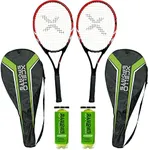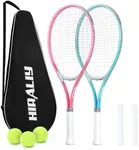Buying Guide for the Best Tennis Rackets
Choosing the right tennis racket can significantly impact your game, whether you're a beginner or an advanced player. The right racket can enhance your strengths, compensate for weaknesses, and help prevent injuries. When selecting a tennis racket, consider factors such as your playing style, skill level, and physical condition. Here are some key specifications to consider when choosing a tennis racket and how to navigate them to find the best fit for you.Head SizeHead size refers to the surface area of the racket's string bed, measured in square inches. A larger head size (over 105 square inches) provides a larger sweet spot, making it more forgiving and easier to generate power, which is ideal for beginners or players who need extra power. Mid-sized head sizes (between 95-105 square inches) offer a balance of power and control, suitable for intermediate players. Smaller head sizes (under 95 square inches) provide more control and precision, preferred by advanced players who can generate their own power and want more accuracy.
WeightThe weight of a tennis racket affects its power, control, and maneuverability. Heavier rackets (over 11 ounces) offer more power and stability, making them suitable for advanced players with strong swings. Medium-weight rackets (9.5-11 ounces) provide a balance of power and control, ideal for intermediate players. Lighter rackets (under 9.5 ounces) are easier to handle and maneuver, making them a good choice for beginners or players who prefer a faster swing. Consider your strength and playing style when choosing the weight of your racket.
BalanceBalance refers to the distribution of weight in the racket, which can be head-heavy, head-light, or evenly balanced. Head-heavy rackets provide more power and stability, suitable for baseline players who rely on powerful groundstrokes. Head-light rackets offer better maneuverability and control, ideal for net players who need quick reactions. Evenly balanced rackets provide a mix of power and control, making them versatile for all-court players. Choose the balance that complements your playing style and strengths.
String PatternThe string pattern of a tennis racket refers to the number of main and cross strings. An open string pattern (fewer strings, such as 16x19) allows for more spin and power but may wear out faster. A dense string pattern (more strings, such as 18x20) offers more control and durability but less spin potential. If you prefer hitting with a lot of spin, an open string pattern may be better for you. If you prioritize control and durability, a dense string pattern might be the right choice.
Grip SizeGrip size is the circumference of the racket handle, measured in inches. A proper grip size is crucial for comfort and preventing injuries. Grip sizes typically range from 4 inches to 4 3/4 inches. To find your ideal grip size, hold the racket and see if you can fit the index finger of your other hand between your fingers and palm. If the space is too tight or too loose, adjust the grip size accordingly. A comfortable grip size ensures better control and reduces the risk of tennis elbow.
Frame StiffnessFrame stiffness, or flex, refers to how much the racket bends upon impact with the ball. Stiffer frames (higher stiffness rating) provide more power and less vibration, suitable for players who want extra power and have no arm issues. Flexible frames (lower stiffness rating) offer more control and a softer feel, reducing the risk of arm injuries, ideal for players with arm problems or those who prefer a more controlled game. Choose the frame stiffness based on your power needs and comfort preferences.






















